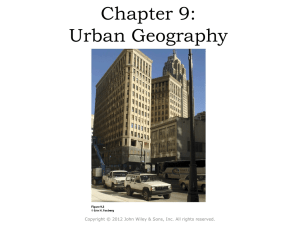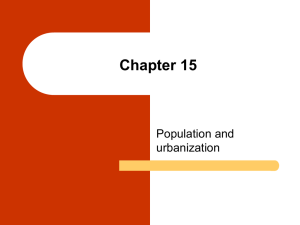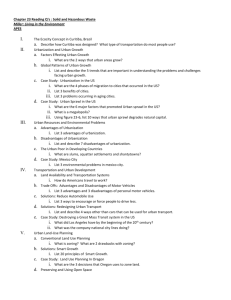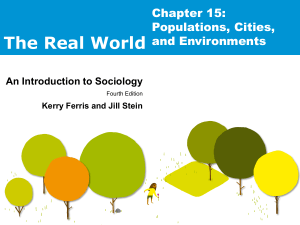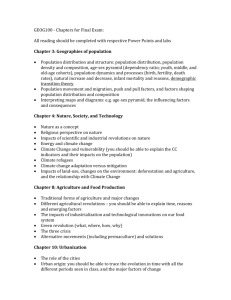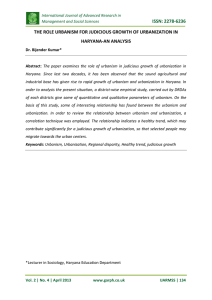2844013698
advertisement
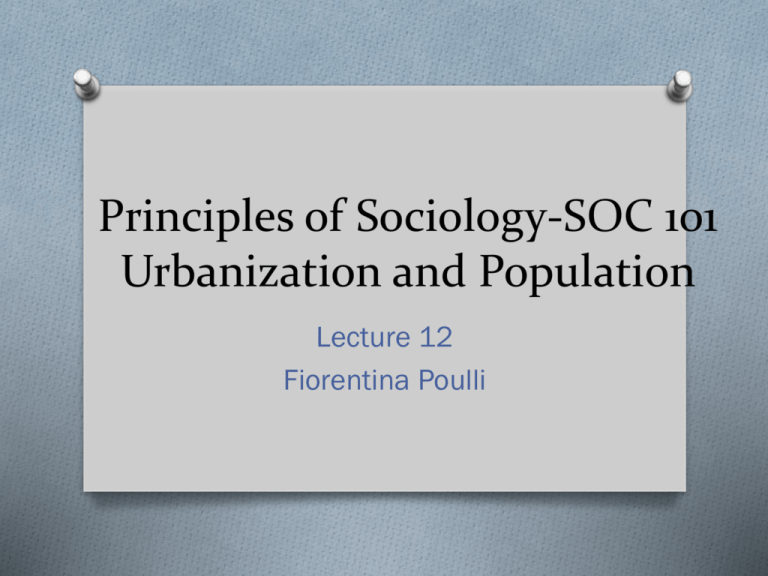
Principles of Sociology-SOC 101 Urbanization and Population Lecture 12 Fiorentina Poulli Outline of the lesson O Understand industrialization and urbanization O Identify global cities; Inequality and the global city O Explain urbanization in the developing world O World population growth; Identify basic demographic concepts. Traditional Cities O Traditional cities differed in many ways from modern urban areas O Traditional cities: small, surrounded by walls, religious buildings etc Living in Cities O In traditional societies only a small minority of the population lived in urban areas O Urbanism is also increasing very rapidly in developing countries O The process of urbanization generated increasing urbanization-the movement of the population into cities. Urbanization is a global-process World urbanization increased-most of this growth has occurred in cities in developing world societies Theories of Urbanism O Chicago School -Urban processes in terms of ecological models derived from biology -Wirth developed the conception of urbanism as a ‘way of life’-how life in cities is distinctive or different from life elsewhere O Later approaches to urban theory have placed more emphasis on the influence if broader socioeconomic factors on city life O Urbanism to be analyzed in relation to major patterns of political and economic change Urban Development O Global-local Issues O The factors that influence urban development locally are part of much more international processes Cities and Globalization O Globalization-a profound effect on cities by making them more interdependent O Globalization and new communications technology might lead to the demise of cities as we know them O Nowadays cities can be carried out in cyberspace Global Cities O Global cities as urban centers that are home to the headquarters of large, transnational corporations and financial services (Sassen) O New York-London-Tokyo-strategic role for major cities Characteristics of global cities Global Cities Nowadays Hong Kong Milan Singapore Los Angeles Frankfurt More cities are joining.. Inequality and the Global city O Global economy-problematic in many ways O New dynamics of inequality visible within the global city O New economy vs traditional economic sectors O People who work in finances and global services receive high salaries thus the areas where they live become gentrified O Duneier argues ‘within global cities a geography of centrality and marginality is taking place’ O Urban redevelopment-poverty on the other side Urbanization in the developing world O Megacities as one of the main features of third millennium urbanization O Megacities are defined not by their size alone but also by their role as connection point between enormous human population and the global economy(Castells) O Population growth is one of the most significant global problems currently faced by humanity O http://www.prb.org/Publications/Datasheet s/2012/world-population-data-sheet/worldmap.aspx#/map/population Challenges of urbanization O Economic Implications O Environmental challenges-pollution, housing shortages, inadequate sanitation etc O Social Effects- poverty, children-education The future of Urbanization in the Developing World •Difficult to see prospects for change and development •Globalization is presenting important opportunities for urban areas in developing countries •Globalization presents one of the most dynamic openings for growing urban centers to become major forces in economic development. World Population Growth O 7 billion people O Impact on the globe, the increasing length of the human life span, the unbalanced human consumption of scarce resources, and unequal living conditions World Population Growth O Much of that growth has happened in Asia — in India and China. Those two countries have been among the world's most populous for centuries. But a demographic shift is taking place as the countries have modernized and lowered their fertility rates. O Now, the biggest growth is taking place in sub-Saharan Africa. Demography O The science dealing with the size, distribution, composition and changes in population O Demographic studies-where population growth is occurring is critical to our understanding of the future Basic Concepts O Life Expectancy O Birth Rate O Mortality O Infant mortality Rate O Life Expectancy Birth Rate •The number of live births per 1000 people in a given year Death Rate •The number of deaths per 1000 people in a given year Infant Mortality Rate: the number of deaths among infants under 1 year of age per 1000 live birthsCyprus 3.6 Life Expectancy: is the expected numbers of years of life-Cyprus 79 years O Questions-Discussion THANKS FOR YOUR ATTENTION!!

